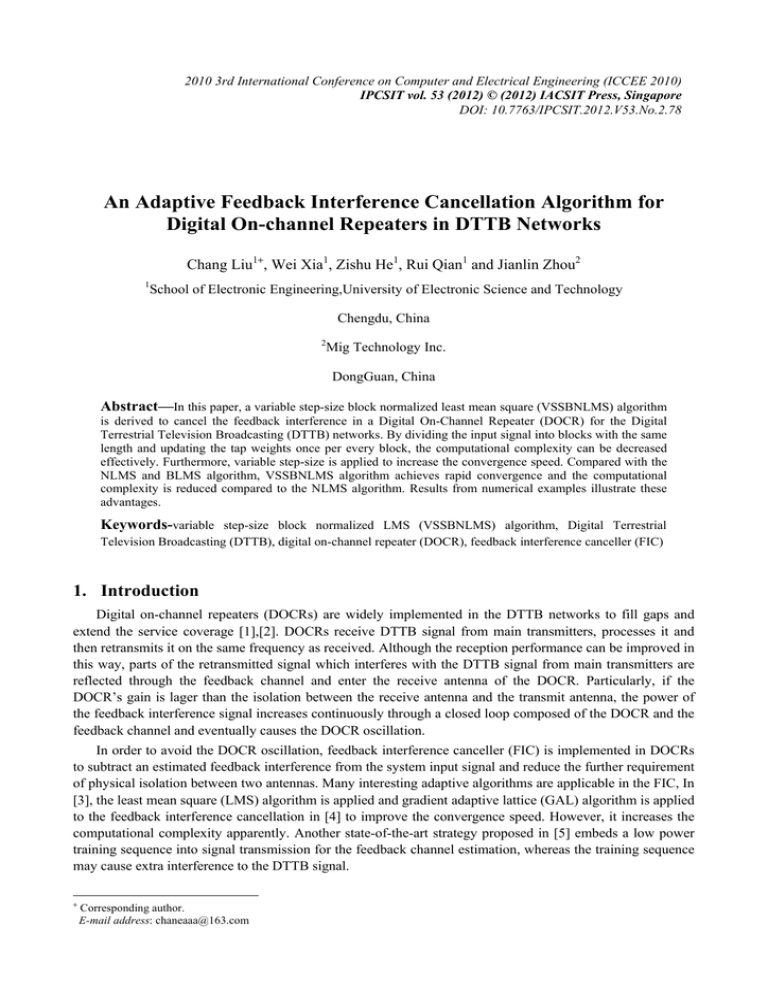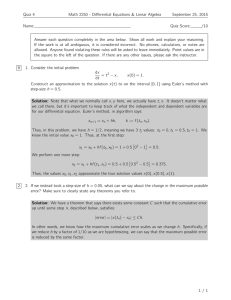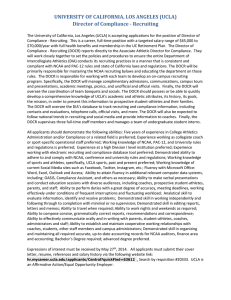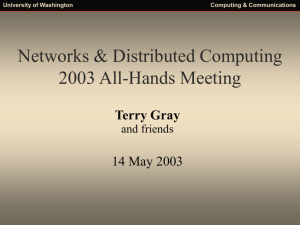Document 13136864
advertisement

2010 3rd International Conference on Computer and Electrical Engineering (ICCEE 2010)
IPCSIT vol. 53 (2012) © (2012) IACSIT Press, Singapore
DOI: 10.7763/IPCSIT.2012.V53.No.2.78
An Adaptive Feedback Interference Cancellation Algorithm for
Digital On-channel Repeaters in DTTB Networks
Chang Liu1+, Wei Xia1, Zishu He1, Rui Qian1 and Jianlin Zhou2
1
School of Electronic Engineering,University of Electronic Science and Technology
Chengdu, China
2
Mig Technology Inc.
DongGuan, China
Abstract—In this paper, a variable step-size block normalized least mean square (VSSBNLMS) algorithm
is derived to cancel the feedback interference in a Digital On-Channel Repeater (DOCR) for the Digital
Terrestrial Television Broadcasting (DTTB) networks. By dividing the input signal into blocks with the same
length and updating the tap weights once per every block, the computational complexity can be decreased
effectively. Furthermore, variable step-size is applied to increase the convergence speed. Compared with the
NLMS and BLMS algorithm, VSSBNLMS algorithm achieves rapid convergence and the computational
complexity is reduced compared to the NLMS algorithm. Results from numerical examples illustrate these
advantages.
Keywords-variable step-size block normalized LMS (VSSBNLMS) algorithm, Digital Terrestrial
Television Broadcasting (DTTB), digital on-channel repeater (DOCR), feedback interference canceller (FIC)
1. Introduction
Digital on-channel repeaters (DOCRs) are widely implemented in the DTTB networks to fill gaps and
extend the service coverage [1],[2]. DOCRs receive DTTB signal from main transmitters, processes it and
then retransmits it on the same frequency as received. Although the reception performance can be improved in
this way, parts of the retransmitted signal which interferes with the DTTB signal from main transmitters are
reflected through the feedback channel and enter the receive antenna of the DOCR. Particularly, if the
DOCR’s gain is lager than the isolation between the receive antenna and the transmit antenna, the power of
the feedback interference signal increases continuously through a closed loop composed of the DOCR and the
feedback channel and eventually causes the DOCR oscillation.
In order to avoid the DOCR oscillation, feedback interference canceller (FIC) is implemented in DOCRs
to subtract an estimated feedback interference from the system input signal and reduce the further requirement
of physical isolation between two antennas. Many interesting adaptive algorithms are applicable in the FIC, In
[3], the least mean square (LMS) algorithm is applied and gradient adaptive lattice (GAL) algorithm is applied
to the feedback interference cancellation in [4] to improve the convergence speed. However, it increases the
computational complexity apparently. Another state-of-the-art strategy proposed in [5] embeds a low power
training sequence into signal transmission for the feedback channel estimation, whereas the training sequence
may cause extra interference to the DTTB signal.
+
Corresponding author.
E-mail address: chaneaaa@163.com
In this paper, based on the variable step-size LMS algorithm (VSSLMS) algorithm [6] and the block
normalized LMS (BNLMS) algorithm [7], we propose a variable step-size block normalized LMS
(VSSBNLMS) algorithm used for the feedback interference cancellation in DOCRs. By dividing the input
signal into blocks with the same length and updating the tap weights once per every block, the computational
complexity can be decreased effectively. Furthermore, variable step-size is applied to increase the
convergence speed. Compared with the other two adaptive algorithms, the VSSBNLMS algorithm achieves
rapid convergence while allowing reduction of the complexity.
This paper is organized as follows. Section 2 presents OCR model with the NLMS algorithm. Section 3
derives the proposed VSSBNLMS algorithm. Section 4 shows the numerical example that indicates the
performance of the proposed algorithm. Section 5 concludes this paper
2. Docr System Model
The DOCR system is modeled as shown in Fig.1, h = [h0 , h2 , , hL-1 ]T is a vector describing the impulse
response of the feedback channel, L is the channel impulse response length and [i]T denotes transpose.
Assuming that the knowledge of the channel impulse response length is known, w (n) = [ w0 (n), w1 (n), , wL-1 (n)]T
is a estimated tap-weight vector of a finite impulse response (FIR) filter which is used to produce an estimate
of the feedback interference signal, where n is the time index .
In the single frequency mode of DTTB networks, the received signal at the DOCR receive end consists of
the target signal coming from the main transmitter, feedback interference and local noise signal
z ( n) = r ( n) + h H x( n ) + v ( n)
(1)
T
where r (n) is the target signal coming from the main transmitter, x(n) = [ x(n), x(n − 1), , x(n − L + 1)] , x(n) is the
reference signal of the FIR filter with zero mean and variance σ x2 = E x(n) 2 , [i]H denotes conjugate transpose.
For simplicity, assume that v(n) is additive white Gaussian noise (AWGN) with zero mean and variance
2
2
σ v2 = E v(n) and r (n) , uncorrelated with v( n) , is zero mean and variance σ r2 = E r ( n) .
r (n )
h
v (n)
y (n )
w (n)
x (n)
y (n )
−
z (n)
e (n)
G
Fig.1. DOCR system model
The FIC subtracts an estimate of the feedback interference at the receive end. Thereby, we get the error
signal
e( n ) = z ( n ) − w H ( n ) x ( n )
(2)
The weights update equation in the NLMS algorithm [8] operated in the channel estimator is
w (n + 1) = w (n) + μ
e* (n)x(n)
x ( n) + ε
2
(3)
where μ is the step-size parameter and ε is a positive constant to avoid by near-zero.
3. Vssbnlms Algorithm
Rather than the tap weights of the filter are updated on a sample-by-sample basis in the conventional
NLMS algorithm, we divide the input signal into blocks with N samples in the proposed VSSBNLMS
algorithm and the tap weights are updated once per every block. The N samples of one block are filtered and
the output errors are produced as
e(kN + i ) = z ( kN + i ) − w H (k )x(kN + i )
i = 0, , N − 1,
where k refers to the block index which is related to the original sample index n and block length N as
(4)
n = kN + i, i = 0,
, N − 1,
(5)
k = 1, 2,
Since the filter significant convergence is depends on the largest output error, small ones result in minor
impact on the convergence [7]. The output error which should be used for the tap weights update is decided
by
(6)
iu = arg max e(kN + i )
i∈{0, , N −1}
The weights update equation in the proposed algorithm is
w (k + 1) = w (k ) + μ (k )
e* (kN + iu )x(kN + iu )
x(kN + iu ) + ε
2
(7)
where μ (k ) is the variable step-size parameter at the kth block, for adjusting the step-size μ (k ) , μ (k + 1) is
calculated as
μ (k + 1) = αμ (k ) +
γ
N −1
∑ e(kN + i)
N
2
(8)
i =0
with
0 < α < 1, γ > 0
(9)
and the update equation of μ (k ) is given by
⎧ μ min ,
if μ (k + 1) ≤ μ min
⎪⎪
μ (k + 1) = ⎨ μ max ,
if μ (k + 1) ≥ μ max
⎪
⎪⎩ μ (k + 1), otherwise
(10)
where 0 < μmin < μmax . The initial step-size is usually taken to be μ max . The value α is chosen in the range (0,1)
to provide exponential forgetting. γ is taken to be small and chosen in conjunction with α to meet the
misadjustment requirement [6].
In this way, the behavior of the VSSBNLMS algorithm can be described as follows: at the early stage of
adaptation, the output error is large, thus preserving step-size high level and providing fast convergence
speed. When the FIR filter goes toward the steady-state, the output error decreases. Therefore, the step-size
is decreased in order to achieve a desired misadjustment.
The (7) and (8) are calculated once for every block, the number of complex multiplications needed per
sample is (2 L + N ) / N , thus, the total complex multiplications of the VSSBNLMS algorithm is L + (2 L + N ) / N
compared with the complexity of the conventional NLMS update which is 3L complex multiplications.
When L = 16 and N = 4 , the VSSBNLMS algorithm can save about half of the complex multiplications
compared with the NLMS.
4. Numerical Examples
In this section numerical examples are presented in order to verify the performance of the proposed
algorithm. The proposed VSSBNLMS algorithm is compared with the BNLMS algorithm [7] and
conventional NLMS algorithm, the related simulation parameters are shown in Table I. All figures are
obtained by averaging the results over 100 trials of the same experiment.
The experimental OFDM signal used in the simulations is generated based on Chinese DTTB standard
PN420+C3780 mode [9], whose bandwidth is 7.56MHz, the frame head mode of which is PN420. The
sampling frequency is 30MHz. We choose COST207 RA6 as the feedback channel model, the parameters of
which is shown in Table II and the Doppler frequency shift is 0Hz. Therefore, the length of the feedback
channel is 16. In addition, assuming that the gain of DOCR is 60dB and the isolation between the transmitting
and receiving antenna is 45dB.
The normalized square deviation(NSD) is a measure of the convergence properties of the adaptive
algorithm, which is defined as
⎛ w ( n) − h
NSD(n) = 10log10 ⎜
2
⎜
h
⎝
2
⎞
⎟
⎟
⎠
(11)
The residual echo power (REP) is used to evaluate the feedback interference cancellation performance for
DOCRs with a FIC which is defined as
⎛ ∑ M −1 e(n − m) − r (n − m) 2 ⎞
⎟
REP(n) = 10log10 ⎜ m = 0 M −1
2
⎜
⎟
−
r
(
n
m
)
∑
m =0
⎝
⎠
(12)
where M is the length of a window over which the REP is computed and is set to 1000 in the simulations.
To meet the requirement for the sufficient gain margin, the converged REP should be under -15dB [10].
Figure.2 shows the learning curves of NSD for the feedback channel. It is clear to see that the NSD
performance of our proposed VSSBNLMS algorithm are better than that of the BNLMS algorithm and
conventional NLMS algorithm. The proposed algorithm converges faster which can be attributed to the
variable step-size parameter at the early stage of adaptation. The convergence of the BNLMS algorithm is
slower than that of other two algorithms due to the only once tap weights update per every signal block.
Additionally, the computational complexity of the proposed algorithm is reduced compared with the
conventional NLMS algorithm while only a little increase compared with the BLMS because of the
implementation of the variable step-size parameter.
TABLE I.
THE PARAMETER SETTINGS
Parameters
Value
μ
μ min
μ max
α
γ
ε
N
L
0.01
0.01
0.4
0.97
0.001
0.1
4
16
TABLE II.
THE PARAMETERS OF COST207 RA6
Power profile
(dB)
0
-4
-8
-12
-16
-20
Delay
(ns)
0
100
200
300
400
500
Figure.3 shows the REP performance of the three algorithms. It can be seen that all three algorithms can
approach the converged REP which is about -25dB. The proposed VSSBNLMS algorithm has the fastest
convergence, followed by the NLMS and BLMS .
Fig.2. NSD performance of feedback interference
cancellation
Fig.3. REP performance of feedback interference
cancellation
5. Conclusion
This paper introduces the proposed VSSBNLMS algorithm used in a DOCR with a FIC for the DTTB
networks. The proposed algorithm converges faster than the other two algorithms mentioned in the paper,
while significantly reduces the computational complexity of the adaptive filter. Thus, compared with the
NLMS and BLMS algorithm, VSSBNLMS algorithm achieves rapid convergence and the computational
complexity is reduced compared to the NLMS algorithm .
6. Acknowledgment
.The project was supported by 2009 Guangdong-Hongkong Technology Cooperation Funding
(number: 2009205133) and Sichuan science and technology supporting Funding
(number:
2010GZ0149).
7. References
[1] K. Salehian, M. Guillet, B. Caron, and A. Kennedy, “On-Channel Repeater for Digital Television Broadcasting
Service,” IEEE Trans.Broadcasting, vol. 48, no. 2, pp. 97-102, June. 2002.
[2] Y. T. Lee, S. I. Park, H. M. Eum, J. H. Seo, H. M. Kim, S. W. Kim,and J. S. Seo, “A Design of Equalization Digital
On-Channel Repeater for Single Frequency Network ATSC System,”IEEE Trans. Broadcasting, vol. 53, no. 1, pp.
23-37, Mar. 2007.
[3] BBCA. Wiewiorka and P. N. Noss, “BBC R & D White Paper WHP120,” September. 2005.
[4] J. K. Hong, Y. W. Suh, J. Y. Choi, J. S. Seo,“Echo Canceller for On-Channel Repeaters in T-DMB System,” Proc.
IEEE ICACT, IEEE Press,, vol.3, Feb. 2008, pp. 1694-1696.
[5] K. M. Nasr, J. P. Cosmas, M. Bard, and J. Gledhill, “Performance of an Echo Canceller and Channel Estimator for
On-Channel Repeaters in DVB-T/H Networks,”IEEE Trans.Broadcasting, vol. 53, no. 3, pp. 609-618, Spet. 2007.
[6] R. H. Kwong and E. W. Johnston, “A Variable Step Size LMS algorithm,” IEEE Trans.signal processing. vol. 40,
no. 7, pp. 1633-1642. 1992.
[7] C.Schuldt, F. Lindstrom and I. Claesson, “Low-Complexity Adaptive Filtering Implementation for Acoustic Echo
Cancellation,” Proc. IEEE TENCON , IEEE Press ,vol.3, Nov. 2006, pp. 1-4.
[8] S. Haykin, Adaptive Filter Theory, 4th ed. Upper Saddle River, NJ: Prentice-Hall, 2002.
[9] C. R. Anderson, S. Krishnamoorthy, C. G. Ronson, T. J. Lemon, W. G. Newgall, T. Kummetz and J. H. Reed,
“Antenna isolation, wideband multipath propagation measurements, and interference mitigation for on-frequency
repeaters,” Proc. IEEE SouthestCon, IEEE Press, Mar. 2004, pp.110-114.
[10] W. Zhang, Y. Guan, W. Liang, D. He , F. Ju and J. Sun, “An introduction of the Chinese DTTB standard and
analysis of the PN595 working modes,”IEEE Trans.Broadcasting, vol. 53, no.1, pp. 8-13, Mar. 2007.






